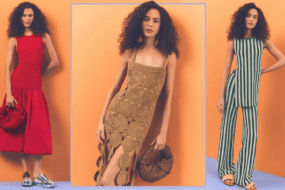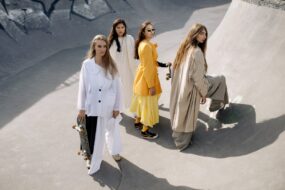
Fashion has long been a reflection of culture, history, and personal identity. At the apex of this expression is high fashion—often referred to as haute couture—which dominates the runways of Paris, Milan, London, and New York. While these extravagant, avant-garde designs may seem inaccessible, they serve as the foundation for trends that eventually make their way into everyday wardrobes. The translation of high fashion into street style is a complex process involving designers, celebrities, influencers, and retailers. This article explores how high fashion shapes mainstream clothing choices and how consumers, knowingly or unknowingly, become part of the fashion cycle.
The Role of High Fashion in Trend Creation
High fashion is the birthplace of trends. Designers push the boundaries of creativity, experimenting with colors, silhouettes, materials, and themes that challenge conventional norms. These designs, while initially exclusive to the elite, gradually trickle down through various channels.
Luxury brands such as Chanel, Gucci, and Louis Vuitton showcase their collections during fashion weeks, where industry insiders—buyers, editors, influencers, and celebrities—take note of key elements. These elements then make their way into ready-to-wear collections, mass-market retailers, and ultimately, street fashion.
One prime example of this phenomenon is the oversized blazer. Initially popularized by designers such as Balenciaga and Saint Laurent, this structured silhouette was seen on models and celebrities before becoming a mainstream wardrobe staple. Similarly, trends like statement sleeves, bold monochrome looks, and utility-inspired clothing have all found their roots in high-fashion presentations.
The Influence of Celebrities and Influencers
Celebrities and social media influencers act as intermediaries between the runway and the general public. Designers often rely on high-profile figures to wear and popularize their creations. When a celebrity steps out in a particular designer piece, it gains visibility and credibility. This endorsement creates demand, prompting fashion retailers to produce more accessible versions for the masses.
Consider the impact of the Kardashian-Jenner family, who have played a significant role in making high fashion more mainstream. Kim Kardashian’s affinity for Balmain and Givenchy has inspired many affordable brands to adopt similar aesthetics. Likewise, the rise of streetwear-influenced high fashion, as seen with brands like Off-White and Yeezy, has blurred the lines between luxury and casual wear.
Social media platforms like Instagram and TikTok accelerate this process. Influencers with millions of followers showcase designer pieces, often styling them in ways that make high fashion more relatable. Fast fashion brands like Zara and H&M quickly pick up on these trends, making them accessible to the average consumer within weeks of their runway debut.
The Role of Fast Fashion and High-Street Retailers
Fast fashion brands play a crucial role in translating high fashion trends into everyday wear. Companies such as Fashion Nova, ASOS, and Forever 21 take inspiration from luxury collections and create budget-friendly versions. While this allows the general public to partake in fashion trends, it also raises ethical concerns regarding sustainability and originality.
High-street retailers like Mango and Topshop act as middlemen between designer exclusivity and fast fashion affordability. They often collaborate with luxury designers for limited-edition collections, further democratizing high fashion. A notable example is H&M’s collaborations with brands like Moschino and Balmain, allowing consumers to own designer-inspired pieces at a fraction of the cost.
Streetwear and High Fashion: A Two-Way Relationship
In recent years, the influence has become reciprocal, with streetwear shaping high fashion just as much as high fashion shapes streetwear. Brands like Supreme and A Bathing Ape (BAPE) have gained luxury status, leading to collaborations with fashion houses such as Louis Vuitton and Dior. This intersection of styles has made casual, relaxed clothing a staple in luxury collections, challenging the notion that high fashion is solely about opulence.
Athleisure, too, has emerged as a major trend due to this shift. Initially influenced by sportswear brands like Adidas and Nike, luxury designers have embraced functional yet stylish athletic-inspired pieces. This has resulted in a growing acceptance of leggings, sneakers, and hoodies as fashion statements rather than mere workout attire.
Cultural and Societal Influences on Fashion Adaptation
Fashion is a reflection of cultural and societal changes. Economic conditions, social movements, and technological advancements all influence how high fashion is adapted for everyday wear. For example, the rise of sustainability has led to an increased demand for eco-friendly materials and ethical production practices. Designers like Stella McCartney and brands such as Reformation prioritize these elements, influencing consumer preferences.
Similarly, diversity and inclusivity have played a significant role in shaping trends. Body positivity movements have encouraged brands to create more size-inclusive clothing, while increased representation of different ethnicities and backgrounds on runways has influenced broader acceptance of diverse fashion aesthetics.
The Future of High Fashion’s Influence on Everyday Style
As technology advances, the way high fashion influences street style will continue to evolve. Digital fashion shows, virtual clothing, and AI-driven designs are becoming more prevalent, creating new opportunities for trend dissemination. The metaverse and digital fashion brands are also expected to reshape the industry, allowing consumers to experiment with high fashion in virtual spaces before integrating elements into their real-world wardrobes.
Sustainability will likely be a dominant theme moving forward, with consumers demanding transparency and ethical production from fashion brands. The slow fashion movement, which emphasizes quality over quantity, is gaining traction and may redefine how trends are adopted in everyday clothing.
Conclusion
High fashion is not just for the elite; it is a powerful force that influences the way people dress on a daily basis. Through designers, celebrities, influencers, and retailers, runway trends gradually become part of mainstream fashion. While accessibility has improved, ethical considerations remain crucial in ensuring a sustainable future for the fashion industry. As the relationship between high fashion and street style continues to evolve, one thing remains certain—fashion will always be a dynamic and ever-changing expression of individuality and culture.






















